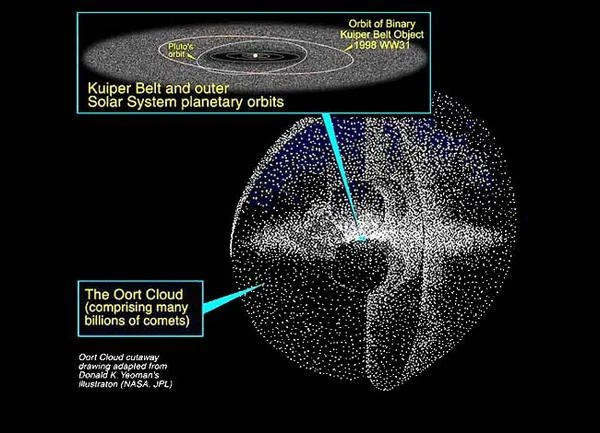
The Oort Cloud is an immense spherical reservoir of small icy bodies, a direct remnant of the primordial nebula that gave birth to the solar system 4.6 billion years ago. According to current estimates, it extends between 2,000 and 100,000 astronomical units (AU) from the Sun, encompassing a region well beyond the heliopause. This hypothetical structure, proposed in 1950 by the astronomer Jan Oort (1900-1992), would explain the origin of long-period comets, whose highly eccentric orbits suggest a very distant origin.
Although invisible, the Oort Cloud plays an essential role in our understanding of the genesis and evolution of the solar system. As a reservoir of primitive material, it constitutes a precious cosmic archive, which can be explored indirectly through the study of comets.
Long-period comets have inclined and eccentric orbits, often retrograde, which suggests an origin consistent with a spherical reservoir of objects with varying inclinations. These objects would be periodically disturbed by external gravitational forces, notably galactic tides or the passage of nearby stars, which would dislodge them from their stable orbit and send them towards the inner solar system.
The objects in the Oort Cloud would be remnants of planetary formation, initially located in the regions close to the giant planets. Through gravitational interactions with Jupiter and Saturn, these small icy bodies would have been ejected to great distances, forming an almost spherical structure. The Cloud is divided into two parts: an inner disk (inner Oort) or (Hills Cloud) whose distance is estimated at ~2,000 to 20,000 AU and an even more diffuse outer halo.
To date, no object clearly belonging to the Oort Cloud has been directly observed. The objects in this distant sphere, located between 20,000 and 100,000 astronomical units, are too far away, too small, and too dark to be detected with current instruments. Even the most extreme known trans-Neptunian objects, such as Sedna or 2012 VP113, are located at less than 100 AU, well below the supposed region of the Oort Cloud. The existence of this cometary reservoir therefore relies solely on dynamic inferences, derived from the statistical analysis of the orbits of long-period comets.
The existence of the Oort Cloud, although universally accepted in models of the formation of the solar system, remains hypothetical. No probe or telescope has yet directly observed the bodies that would compose it. This spherical reservoir of icy objects is deduced solely from the orbital analysis of long-period comets, whose trajectories indicate that they would come from an isotropic, extremely distant region, occasionally disturbed by external forces such as galactic tides or nearby stars.
However, several uncertainties remain. The actual number of comets originating from the Oort Cloud is subject to debate, as is the exact distribution of their orbits. Moreover, some dynamic models allow explaining these comets by extreme trans-Neptunian regions or structures still poorly characterized such as the Hills Cloud. Objects like Sedna or 2012 VP113 raise the possibility of a link between the Kuiper Belt and the Oort Cloud, without directly connecting them.
The lack of direct observation is not sufficient to reject its existence, but it encourages caution: the Oort Cloud is a robust theoretical model, but still without visual proof. Future missions with nuclear propulsion or photon sails could, over the course of several centuries, penetrate this region and confirm or refute its reality.
| Characteristic | Oort Cloud | Kuiper Belt |
|---|---|---|
| Shape | Spherical (isotropic) | Flattened disk (coplanar) |
| Distance from the Sun | 2,000 to 100,000 AU | 30 to 50 AU |
| Typical Objects | Long-period comets | Pluto, Haumea, Makemake, and other trans-Neptunian objects (TNO) |
| Discovery | Hypothetical (Oort, 1950) | Confirmed (since 1992) |
| Stability | Galactic tide influence | Planetary perturbations |
Sources: Dones et al., Icarus 207 (2010) and Trujillo and Sheppard, Nature (2014).